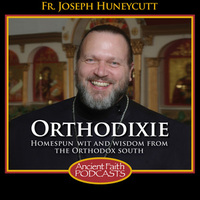 First, as you know, Indonesia is the most Muslim of nations. That’s why your help is most needed.
First, as you know, Indonesia is the most Muslim of nations. That’s why your help is most needed.
Did you know about Orthodox Christianity in Indonesia?
Thanks to FWD from Fr Gordon Walker.
Secondly, my cyber pal, Jean-Michel, sent along this link which contains just about every single Christ-mas song you can think of and gobs of ’em flown in straight from obscurity. (See, I told you St Joseph was an old man!)
Jean-Michel, by the way, was the first person to buy One Flew Over the Onion Dome directly from the author. It’s kind of exotic when you realize he lives in Belgium!
What? Got that special someone who has everything — but suddenly you realize he doesn’t have my book? PayPal, side margin, to the rescue!
And … now THIS is E-vangelism all Orthodox-like. Cool!
Finally, someone (I believe it was Fr Victor Potapov from St John Baptist Cathedral, Washington, DC) sent along this link & review about an exciting Bible Exhibit.
A current museum exhibit that you might want to visit – “In the Beginning:
Bibles Before the Year 1000″ at the Arthur M. Sackler Gallery of Art in
Washington, DC.
One of our parishioners wrote this review:
I visited the museum this past Saturday and enjoyed the exhibit a lot.
In the exhibit you can see over 70 of the earliest biblical artifacts in existence, including pages and fragments written in Greek, Latin, Hebrew, Arabic, Syriac, Armenian, Ethiopian, Coptic, and even Glagolitic!
All exhibits have some kind of bias, and this one if no exception. From the earlier review in I had read in The Washington Post,I was expecting to find the objects accompanied by all the worst sorts of atheist propaganda about how much evolution the Bible had to undergo before it ultimately reaching its settled state; how the authorities worked at suppressing writings from the Christian communities that might have a potential to subvert the dogmatic teachings of the canonical texts; and how the modern techniques of textual criticism have allowed us to scientifically re-construct the “original” sayings of the authors, as separate from later “distortions” inserted by the church authorities, etc.
I was pleased to see that these modernistic elements were hardly in play at all. In fact, the whole presentation was quite reverent towards the texts as deserving of sacred status, and utterly respectful towards the labors of those who made the choice to dedicate all their efforts to copying, illuminating, and preserving them. One literally walks away from this exhibit with the feeling of amazement — not at how MUCH the Bible had to evolve over the course of its development, but how LITTLE! How eloquently this testifies to the stability of faith of the church that was entrusted with making the message of the Gospel available for the enlightenment of the world!
A lot of mention is made of the various archeologists and benefactors who are credited with the “discovery” (though, one sometimes wonders if it might be more accurate to say “stealing”) of early fragments, especially the American early 20th-Century industrialists Charles Lang Freer and Alfred Chester Beatty. Interestingly to me, no mention is made of the Russians, notably Tsar Alexander II, whose patronage made possible the discovery of one of the most significant manuscripts, the Codex Sinaiticus, a 4th century Greek manuscript of the entire Bible in its complete canonical unity as we know it today in the Orthodox Church, with both the Old and New Testaments, including the 15 deutero-canonical books of the Old Testament that were thrown out by the Protestant Reformers.
Two pages from Codex Sinaiticus from the book of the Prophet Ezekiel are the highlight in the exhibit; these were among latter-discovered fragments that were unearthed during restoration works at St. Catherine’s monastery in 1975.
Probably the one impression that will stick with me the longest after the exhibit has closed, is what I was able to observe of how the museum visitors were responding to the exhibit. There were many families. The parents’ comments about the items on display were vivid and remarkably informed. It was evident that many of them were faithful Believers and that they were viewing the experience as a chance to identify with the faith of centuries’-past forebears.
Somehow the exhibit manages to convey the idea that the workmanship of the scribes was not just a boring and tedious endeavor that was groaning for the soonest invention of the printing press and copy machines, but was itself a holy podvig that was worth all expense and effort to undertake. I felt myself drawn in with the spirit of those unnamed scribes whose handling of the words of life was like that expressed by the Prophet David: “The law of Thy mouth is better to me than thousands of gold or silver.” (Ps. 118)











